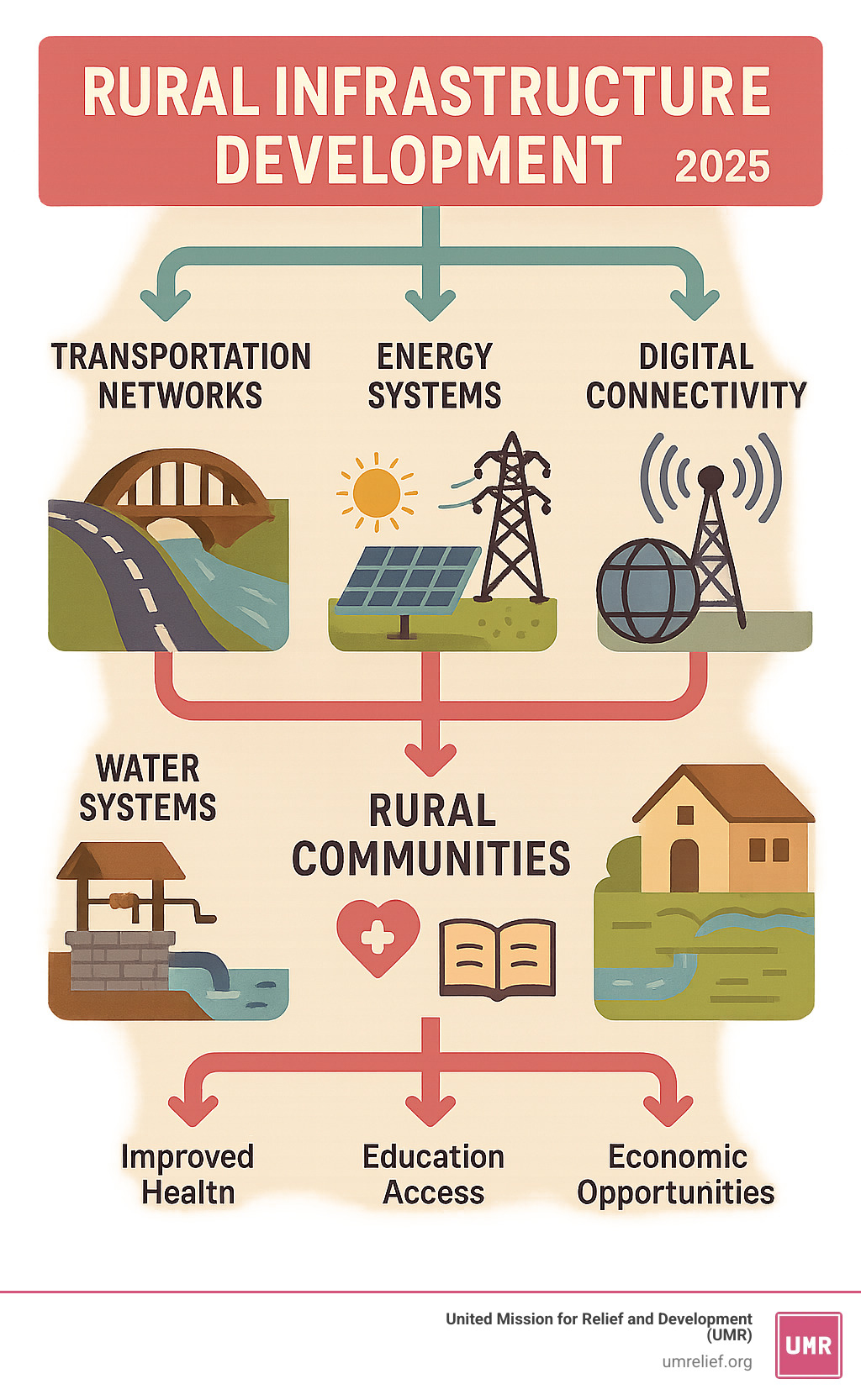Rural Infrastructure Development: 4 Crucial Pillars
Why Rural Infrastructure Development is the Foundation of Thriving Communities
Rural infrastructure development is the backbone of sustainable communities, connecting remote areas to essential services and economic prosperity. For donors seeking maximum impact, understanding this foundation is crucial.
Key components include:
- Transportation networks like roads and bridges
- Energy systems, including renewable power
- Digital connectivity such as broadband internet
- Water and sanitation systems
- Social infrastructure like schools and healthcare facilities
The investment needs are significant, reaching 5.5% of GDP in middle-income countries and 9% of GDP in the least developed countries. The impact, however, extends far beyond economics. A study in Ghana highlighted a stark reality: “Most of the people suffering from hunger around the world live in rural areas and engage in agricultural activity. It is not a coincidence that they also often lack basic services, such as energy and irrigation provision, due to a lack of infrastructure.”
This investment creates a powerful “multiplier effect.” Reliable roads, clean water, and electricity transform communities by improving market access, boosting social development through better education and healthcare, and empowering residents with new opportunities. This infrastructure builds the foundation for long-term resilience in the world’s most vulnerable communities.

The Foundations of Prosperity: Why Rural Infrastructure is a Global Priority
Rural infrastructure development is the economic backbone and social fabric that holds communities together. Without it, populations can remain trapped in cycles of poverty, unable to access basic services. At UMR, we’ve seen how the absence of infrastructure creates a domino effect of challenges in communities across Yemen, Sudan, and Pakistan. But when communities gain access to proper infrastructure, it creates pathways out of poverty and foundations for lasting prosperity.
What Constitutes Rural Infrastructure?
Rural infrastructure consists of three interconnected layers:
- Physical infrastructure: Tangible assets like roads, bridges, irrigation systems, and energy grids. These are often called “hard” infrastructure.
- Social infrastructure: Facilities focused on human development, such as schools, healthcare clinics, and community centers.
- Economic infrastructure: Structures that create prosperity, including market centers, storage facilities, and processing centers.
Beyond these physical structures, “soft” infrastructure—the institutional frameworks, policies, and human capacities—is essential for making everything work sustainably.
The Ripple Effect on Economic and Social Well-being
When these infrastructure pieces work together, the impact is transformative. A farmer with a new road can get fresher produce to market, increasing her income. That income allows her to send her children to school, who then grow up with expanded opportunities.
Job creation extends beyond farming to include maintenance crews, technicians, and clinic staff. Crucially, good infrastructure reduces the pressure for rural-to-urban migration by making it possible to access healthcare, education, and economic opportunities at home.
Research on infrastructure’s impact on local economies confirms that strategic investment empowers entire communities to build sustainable futures. When communities gain reliable infrastructure, they gain dignity, hope, and the tools to solve their own challenges.
The Pillars of Progress: Essential Components of Rural Infrastructure Development
Rural infrastructure development relies on interconnected systems. At UMR, we practice holistic development, knowing that a new school is only effective if children have safe roads to reach it, solar panels to study at night, and clean water to stay healthy. These foundational services create synergistic effects, where each improvement amplifies the others.
Transportation: Paving the Way to Market Access
Good roads and bridges connect farmers to markets, patients to hospitals, and children to schools. Lower transport costs boost agricultural productivity and reduce post-harvest loss. Recognizing this, the U.S. Infrastructure Investment and Jobs Act allocated $110 billion for roads, while China had paved main roads in 99.1% of villages by 2021.
Energy: Powering Productivity and Modern Life

Electricity access is critical, yet 85% of those without it live in rural areas. Off-grid solutions like solar panels are transformative, allowing children to study after sunset, businesses to operate longer, and clinics to refrigerate medicines. As information on rural energy access shows, renewable energy is often the most practical and resilient choice for remote communities.
Digital Connectivity: Bridging the Broadband Gap
High-speed internet is essential for breaking poverty cycles. It enables e-commerce for farmers, telemedicine, and online education. The digital divide remains a challenge; a Canadian report on the state of broadband service shows that only 37% of rural households had adequate speeds compared to 97% in cities. Closing this gap requires investment and promoting digital literacy.
Water and Sanitation: The Lifeline of Health and Agriculture
Clean drinking water and sanitation facilities save lives by preventing disease and freeing up time for education and income-generating activities. In places like Madagascar, UMR’s water projects have dramatically improved school attendance and family health. Furthermore, irrigation systems can double agricultural yields compared to rain-fed farming, ensuring food security and higher incomes.
Navigating the Challenges: Strategies for Successful Implementation
Implementing rural infrastructure development projects involves overcoming significant challenges. At UMR, we steer financial constraints, logistical problems, and policy gaps through smart planning and genuine community participation. The key is to build lasting solutions with the people who will use them every day.
Overcoming Problems in Rural Infrastructure Development
Major problems for rural projects include:
- High initial costs: Low population density means higher per-person costs for services.
- Difficult terrain: Remote and mountainous regions, like those in Lebanon and Kenya where UMR works, increase logistical complexity and expense.
- Skilled labor shortage: Finding specialized workers in rural areas can be difficult.
- Maintenance and sustainability: Long-term upkeep is crucial but often underfunded.
- Lack of political will: Rural areas can be overlooked in budget decisions.
The following table compares traditional and innovative funding models:
| Feature | Traditional Funding | Innovative Models (e.g., PPPs, Impact Investing) |
|---|---|---|
| Source | Government budgets, public loans, multilateral banks | Private investors, corporations, foundations, community funds |
| Risk Bearing | Primarily public sector | Shared between public and private sectors |
| Efficiency | Can be slower, less agile | Often faster, more efficient, leveraging private sector expertise |
| Focus | Public good, social welfare | Public good, but also financial return or social impact |
| Sustainability | Dependent on ongoing public funding | Can incorporate long-term maintenance contracts, revenue streams |
| Transparency | Variable | Often improved by private sector accountability requirements |
Innovative Financing and Supportive Policies
Creative solutions are essential for funding rural infrastructure. Public-Private Partnerships (PPPs) combine government oversight with private sector capital and expertise. Impact investing attracts investors who seek both financial and social returns, while blended finance uses public money to de-risk projects for private investors.
These models thrive with supportive legal frameworks and policies like government subsidies. As this Report on financing rural infrastructure details, new financial instruments can create a robust infrastructure base for rural communities. At UMR, we find that combining multiple funding sources with deep community involvement leads to the most successful and sustainable projects.
Reaping the Rewards: How Infrastructure Transforms Rural Lives
When we talk about rural infrastructure development, we’re really talking about change. The kind that changes everything – from how families eat dinner to whether children can dream of college. At UMR, we’ve witnessed these changes across communities from Jordan to Bangladesh, and the results never cease to amaze us.
Enhancing Food Security and Reducing Waste
Better roads and storage facilities connect farmers to markets, reducing spoilage and increasing incomes. This is critical when, as the FAO report on food loss and waste notes, roughly 1.3 billion tonnes of food are lost or wasted globally each year while 821 million people face hunger. Infrastructure helps bridge this gap by creating efficient supply chains, stabilizing prices, and making nutritious food more accessible.
A Pathway Out of Poverty
Infrastructure creates economic opportunities beyond agriculture. Reliable roads, electricity, and communication foster the growth of non-agricultural jobs and small businesses. This leads to diversified livelihoods, making families more resilient to economic shocks. A study on infrastructure and poverty reduction in India confirms the strong link between infrastructure investment and increased household incomes.
Improving the Rural Living Environment
The benefits extend to daily life. Proper waste treatment and access to public transport create cleaner, healthier, and more inclusive communities. Better infrastructure also enables improved housing and ensures access to clean air and water. As research on rural living environment governance shows, these improvements create vibrant communities where families can thrive.
Building for the Future: Technology and Equity in Rural Development
The future of rural infrastructure development depends on combining cutting-edge technology with a commitment to equity. Smart, data-driven infrastructure can maximize resources, but these advances must reach every community.
The Role of Technology in Modern Rural Infrastructure Development
Technology is revolutionizing rural projects. IoT sensors optimize water management, while drones make surveying remote areas in places like Yemen and Sudan faster and safer.
Digital payment systems secure financial transactions for farmers, and smart grids deliver reliable renewable energy. Mobile apps can provide farmers with market data, and low-tech solutions like Interactive Voice Response systems ensure information reaches everyone. As this article on digital infrastructure’s impact shows, the goal is “meaningful connectivity” that improves daily life.
Ensuring Equitable Development Across Regions
No two rural communities are alike; a solution for Bangladesh may not work in Somalia. That’s why UMR’s approach is rooted in community-based participatory research. We listen to local leaders and families to understand their unique needs, whether it’s a school, clean water, or a road.
This is especially true when working with indigenous communities or in places like Palestine, where respecting cultural values is paramount. Remote communities require custom, flexible strategies that account for their specific challenges. The goal is to empower communities to thrive on their own terms by addressing regional disparities and ensuring development benefits everyone. An action plan for informing education policy in rural Manitoba offers a strong framework for this community-centered approach.
Frequently Asked Questions about Rural Infrastructure Development
Here are answers to common questions about rural infrastructure development, based on our work in places like Yemen, Sudan, and Bangladesh.
Why is rural infrastructure often more expensive to build than urban infrastructure?
Rural projects typically have a higher per-person cost due to several factors:
- Lower population density: Fewer people share the cost of extensive infrastructure.
- Lack of economies of scale: Materials cannot be purchased in large, cost-saving quantities.
- Difficult terrain: Natural barriers increase transportation and construction costs.
- Longer supply chains: Transporting materials and skilled labor to remote sites is expensive.
What is the role of the local community in infrastructure projects?
Local communities are essential partners, not just beneficiaries. Their involvement ensures projects are successful and sustainable. Their role includes:
- Needs identification: Community members best understand their own priorities.
- Project planning: Local knowledge of the environment and culture leads to better design.
- Ownership and maintenance: Participation fosters a sense of ownership, which is critical for long-term upkeep.
- Cultural appropriateness: Local guidance ensures solutions fit community norms and routines.
How does climate change affect rural infrastructure planning?
Climate change requires a new approach to infrastructure. We must plan for a future with more extreme weather. Key considerations include:
- Increased risk: Infrastructure must be designed to withstand more intense floods, droughts, and storms.
- Climate-resilient materials: Using durable materials costs more initially but saves money by preventing future damage.
- Updated standards: Building codes must reflect the latest climate science.
- Disaster mitigation: Projects must incorporate features like early warning systems and protective barriers.
The Canadian framework on clean growth and climate change offers guidance on building this resilience.
Conclusion
Rural infrastructure development is about more than concrete and steel; it’s about hope, opportunity, and the right to thrive. When a farmer in Sudan can reach a market or a child in Bangladesh can study at night, lives are transformed. This work is a powerful catalyst for community-wide change.
The path forward has challenges, from financial constraints to difficult terrain, but innovative solutions offer hope. Public-private partnerships, smart technology, and community participation are making a real difference.
At UMR, we see how foundational infrastructure becomes the bedrock for all other progress. Helping build a clean water system in Yemen or supporting energy access in Pakistan lays the groundwork for generations of opportunity. Our approach is centered on transparent and sustainable partnerships that create lasting change.
Behind every statistic on reduced hunger or increased income is a person connected to new possibilities. The road ahead requires a shared commitment from governments, organizations, communities, and donors. By investing in rural infrastructure, we are building the foundation for thriving communities that will flourish for decades.
Find how UMR empowers communities through livelihood support programs and find how your support can help build these vital foundations for communities around the world.









